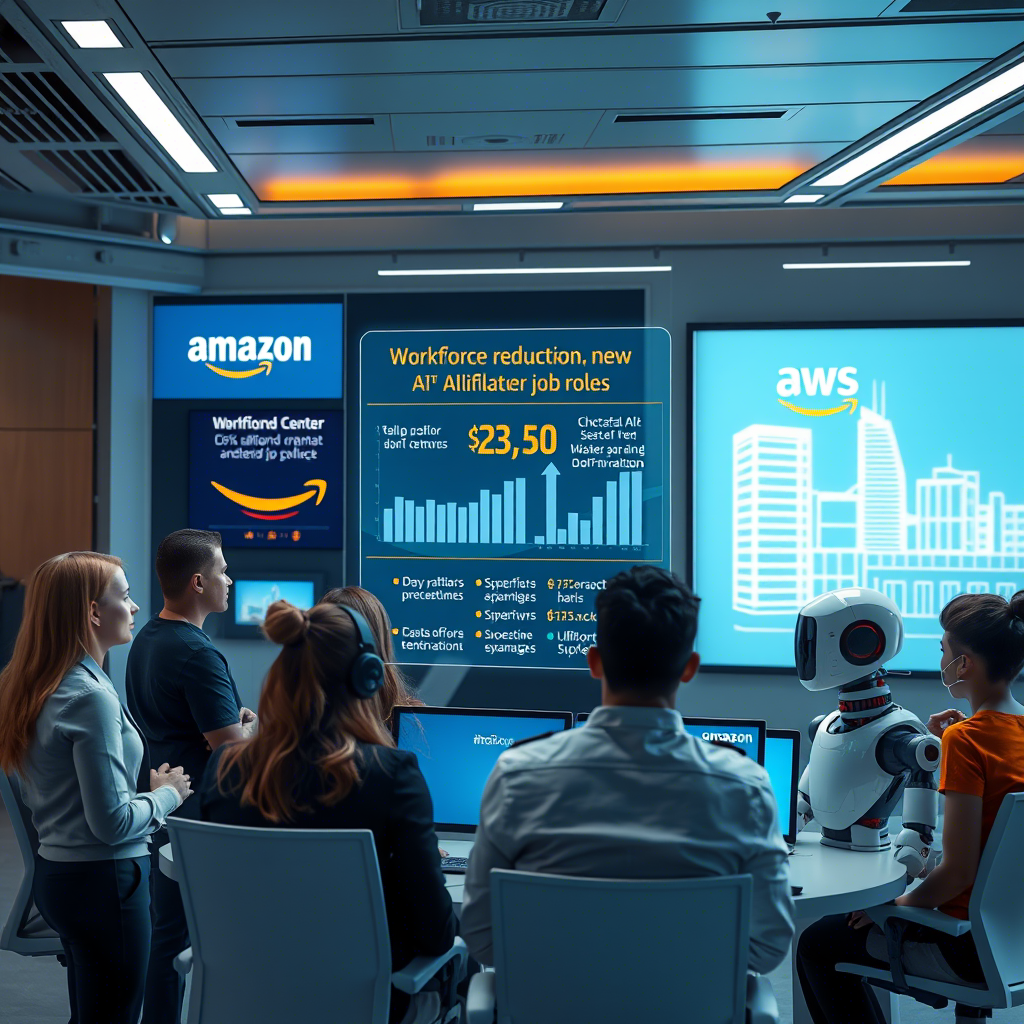Amazon CEO Andy Jassy sent a memo to employees on June 17, 2025, outlining a transformative vision for the company’s future, one that places generative artificial intelligence (AI) at the forefront of its operations. The announcement, which has reverberated across the tech industry and beyond, signals a significant reduction in Amazon’s corporate workforce over the next few years as the company leans heavily on AI to streamline tasks and boost efficiency.

With approximately 1.56 million employees worldwide as of March 2025, Amazon’s shift toward automation is poised to reshape not only its own workforce but also the broader conversation around the future of work in an AI-driven economy.
A New Era of Efficiency Through Generative AI
Jassy’s memo, shared publicly on Amazon’s blog, paints a picture of a company fully committed to integrating generative AI across its operations. “As we roll out more Generative AI and agents, it should change the way our work is done,” Jassy wrote. “We will need fewer people doing some of the jobs that are being done today, and more people doing other types of jobs.” This statement underscores a pivotal shift: while some roles will diminish, new opportunities will emerge, requiring employees to adapt to a rapidly evolving technological landscape.
Amazon, the second-largest private employer in the United States, is already leveraging generative AI in nearly every corner of its business. From improving inventory placement and demand forecasting in its fulfillment network to enhancing the efficiency of warehouse robots, AI is driving measurable gains. For instance, Jassy noted that an AI coding assistant saved Amazon programmers 4,500 years of work by accelerating software upgrades. The company has also rolled out AI-powered products like Alexa+, a smarter and more capable version of its virtual assistant, and an AI shopping assistant used by tens of millions of customers to make informed purchase decisions.
With over 1,000 generative AI services and applications either in development or already deployed, Jassy described this as “a small fraction” of what Amazon plans to build. He called generative AI a “once-in-a-lifetime” technology, comparing its transformative potential to the internet. This conviction has driven Amazon to invest heavily, with plans to spend $100 billion in 2025 on AI services and data centers, up from $83 billion the previous year.

The Workforce Impact: Reductions and Reshuffling
The core of Jassy’s message is a stark reality: the widespread adoption of generative AI will lead to a smaller corporate workforce. While exact numbers and affected departments remain undisclosed, Jassy acknowledged that “it’s hard to know exactly where this nets out over time,” but he expects a reduction in headcount as AI automates routine and repetitive tasks. Amazon’s corporate workforce, which includes roles like software engineering and marketing, accounts for roughly 350,000 of its 1.56 million global employees.
This announcement follows a trend of workforce reductions at Amazon. Since 2022, the company has laid off approximately 27,000 employees, with smaller cuts in 2025 targeting teams like books and devices. Internal Slack messages shared with The Washington Post reveal employee concerns, with some noting that layoffs and attrition without replacement have become commonplace. Jassy’s memo, however, frames these changes as part of a broader transformation rather than mere cost-cutting. He emphasized that AI will not only eliminate jobs but also create new roles, particularly in AI development and implementation.
The shift is not unique to Amazon. Other tech giants, including Microsoft, Google, and Shopify, have tied workforce reductions to AI investments. Shopify’s CEO, Tobi Lutke, has required managers to justify hiring by proving tasks cannot be automated, while Klarna reduced its headcount by 40% through AI and natural attrition. A World Economic Forum survey found that 40% of employers plan to cut roles that AI can automate, signaling a global trend toward workforce reshuffling.
Industry Reactions and Ethical Concerns
Jassy’s announcement has sparked a mix of reactions, from cautious optimism to outright concern. On X, posts reflect a polarized sentiment: some view AI-driven efficiency as a necessary evolution, while others fear widespread job losses without adequate retraining programs. HR consultant Bryan Driscoll, speaking to Newsweek, criticized Amazon’s approach, arguing that the company, with its vast resources, could lead in responsible AI use but is instead prioritizing shareholder value over workers. “If one of the world’s most influential employers is normalizing mass workforce cuts in the name of AI, expect other companies to follow,” Driscoll warned.

The ethical implications of AI-driven layoffs are a growing concern. Anthropic’s CEO, Dario Amodei, recently estimated that AI could eliminate half of entry-level white-collar jobs, a prediction that resonates with Amazon’s strategy. Critics argue that without robust labor protections or reskilling initiatives, workers bear the brunt of automation’s impact. In Washington state, over 40% of recent layoffs targeted software engineers, many of whom were previously tasked with integrating AI tools into their workflows—only to be replaced by those same systems.
Amazon’s scale amplifies the stakes. As a bellwether for the U.S. job market, its actions could influence other industries, from retail to logistics. The company’s aggressive AI push, including a $4 billion investment in Anthropic and custom AI chips for AWS, positions it as a leader in the AI race, but it also raises questions about balancing innovation with social responsibility.
Adapting to the AI Era: Jassy’s Call to Action
Jassy’s memo is not just a warning but a call to action for employees. He urged workers to embrace AI by attending workshops, experimenting with tools, and participating in team brainstorms to innovate for customers. “Those who become conversant in AI, help us build and improve our AI capabilities, and deliver for customers will be well-positioned to have high impact,” he wrote. Reflecting on his early days at Amazon in 1997, Jassy highlighted the value of “scrappier teams” that achieve more with fewer resources, signaling a return to a leaner, startup-like culture.
This push for adaptation aligns with industry trends. Companies like Duolingo and BT are also phasing out roles that AI can handle, with executives emphasizing the need for workers to upskill. However, the speed of AI adoption may outpace reskilling efforts, leaving some employees vulnerable. Amazon’s focus on AI-driven efficiency, from rebuilding its customer service chatbot to assembling smarter product detail pages, suggests a future where human roles are redefined by their ability to complement AI systems.

The Bigger Picture: AI’s Societal Impact
Amazon’s workforce reduction is part of a larger narrative about AI’s transformative potential. Jassy envisions a future with “billions” of AI agents across industries, handling tasks from shopping to research. While many of these agents are still in development, their rapid advancement—evident in products like Alexa+ and Amazon’s Nova models—suggests a seismic shift in how work and daily life are structured.
The tech industry’s layoffs, totaling over 62,832 in 2025 according to Layoffs.FYI, reflect this shift. From Microsoft’s $80 billion AI investment to Google’s workforce cuts, companies are prioritizing AI over traditional roles. Yet, experts argue that AI will not lead to mass unemployment but rather a reallocation of labor. Roles in AI development, data science, and ethics are expected to grow, even as routine tasks disappear.
Amazon’s embrace of generative AI marks a turning point for the company and the industry. While Jassy’s vision promises innovation and efficiency, it also underscores the challenges of navigating an AI-driven future. For Amazon’s 1.56 million employees, the message is clear: adapt to AI or risk obsolescence. As the company continues to invest in AI infrastructure and products, the world will be watching how it balances technological progress with its responsibility to its workforce.

The broader implications for society are profound. Amazon’s strategy could set a precedent for how corporations integrate AI, potentially reshaping labor markets and economic policies. For now, Jassy’s memo serves as both a roadmap and a warning: the age of AI is here, and it’s changing everything.
Copyrights: Dhaka.ai



